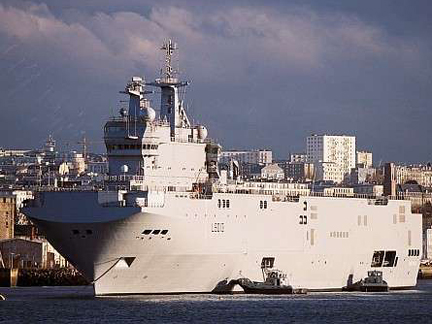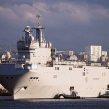
Mistral and Other Arms Sales to Russia Mark NATO’s First Post-Summit Defeat (Part One)
Publication: Eurasia Daily Monitor Volume: 8 Issue: 1
By:

On Christmas Eve (December 24, 2010) the Kremlin and Elysee Palace jointly announced a definitive agreement for Russian procurement of two French Mistral-class power projection warships, with two more planned for a follow-up stage. Presidents Dmitry Medvedev and Nicolas Sarkozy exchanged congratulations over this deal and in the Christmas season by telephone. Separately, the Elysee Palace described the deal’s consummation as a victory for France and its naval industry, with 1,000 French jobs guaranteed for the first two ships in the four years ahead (Interfax, Agence France Presse, December 24, 25, 2010). Sarkozy’s long-time friend and leading French pundit, Andre Gluecksmann, however, termed the Christmas-eve announcement as intended to distract public attention from a “dirty” affair (The New York Times, December 29, 2010).
In parallel, a number of bilateral arms deals between NATO countries and Russia are now being consummated, without reference to their impact on the Alliance’s defense planning, or the security interests of NATO member and partner countries that border on Russia. The French Mistral deal seems to have opened a floodgate of arms sales to Russia by West European arms industries (see Part Two). These deals were in the offing before NATO’s Lisbon summit on November 20-21, but Russian confirmations were held in abeyance until the summit was over. In this regard, the Lisbon summit may indeed have marked a “historic” watershed, though not in the sense conveyed in the immediate post-summit euphoria.
Mistral-class warships are designed for offensive power-projection through amphibious landings and air assault, using the combat helicopters and armored vehicles aboard in support of ground-force operations. Under Russia’s military doctrine, as well as command arrangements in the Black Sea and the Baltic Sea, naval forces are regarded as auxiliary to ground forces in the event of offensive operations on land. Such was also the Russian Black Sea Fleet’s role in the August 2008 invasion of Georgia, following which the Kremlin decided to procure Mistral-class warships for exponentially enhanced ship-to-shore attack capabilities.
These warships carry 16 combat and troop-transport helicopters, some 70 armored vehicles (or alternatively two dozen battle tanks), and 750 ground troops with craft and hovercraft for amphibious landing. The ratios of helicopters to armor to troops are flexible ratios, depending on mission. The Russian side has announced its intention to put Ka-29 and Ka-52 helicopters on Mistral-class ships after the procurement. Moscow has yet to announce what solution it considers for the armor aboard ship. Russian defense ministry top officials are publicly disdainful of the quality of Russian armored vehicles, and shopping for Western models. Thus, it should not come as a surprise if Moscow decides to seek a West-European tank model to put aboard the Mistral.
Under the Christmas-Eve announcement, a consortium of two French shipyards will build these warships jointly with Russia’s United Shipbuilding Corporation (OSK). Construction is due to start at the Saint-Nazaire shipyard in 2011, with the first ship to be delivered by the end of 2013 and the second by the end of 2014. According to OSK’s spokesman, the Russian side would contribute 20 percent of the construction work for the first ship, and 40 percent for the second. This claim seems wishful thinking and has not been corroborated by the French side thus far. Paris will certainly do its utmost best for French jobs, although not for security in Europe’s East. The third and fourth warships are planned to be built at OSK shipyards in Russia under French licenses. Moscow intends to deploy one ship of this class with each of Russia’s four fleets (Baltic, Black Sea, Northern and Pacific) (Interfax, December 25; RIA Novosti, December 30, 2010).
Russia’s defense ministry claims to have set aside the funding for the first two ships in the ministry’s procurement budget. It would, again, not come as a surprise if this claim is exaggerated and the French side ends up financing part of the work on credit. The procurement costs are estimated at $650 million to $720 million per ship for the first two ships to be built in France (Rossiyskaya Gazeta, December 28; Interfax, RIA Novosti, December 30, 2010).
Controversy over transferring advanced technology to Russia had affected the Franco-Russian bargaining, particularly over the Mistral’s command-control-communications systems. In early December 2010, French Prime Minister Francois Fillon relented, to Moscow’s apparent satisfaction. Following his talks with Medvedev and Russian Prime Minister, Vladimir Putin, in Moscow, Fillon announced that France is “ready to transfer the technology to Russia, if it wins the tender” (Agence France Presse, December 9, 2010). OSK’s spokesman declared full satisfaction on this score after the joint Kremlin-Elysee announcement (Interfax, December 25, 2010). Fillon will be remembered for opposing the NATO-Georgia membership action plan at the Alliance’s 2008 summit, arguing that such a plan would change the “balance of power” to Russia’s detriment.
Moscow had announced its decision to procure Mistral-class warships in the fall of 2008, immediately after its invasion of Georgia, and linking its decision explicitly to the lessons learned from that war. To make Paris nervous, Moscow announced an international tender for procurement of warships of this class in August 2010, and confirmed the tender in October. Shipyards from the Netherlands, Spain, and South Korea expressed interest. This move goaded France into agreeing the terms and finalizing the Mistral deal in December, only two months after Moscow’s confirmation of this Potemkin tender.




